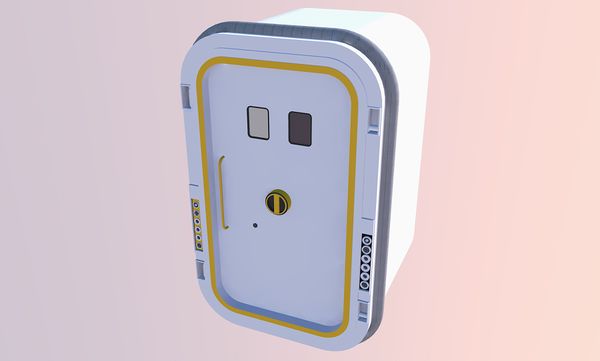Difference between revisions of "Airlock"
| Line 9: | Line 9: | ||
*Airlock doors must resist the internal air pressure of the vehicle or habitat, than can carry between 5 and 14,7 psi, or about 4 to 10 tonnes of pressure per meter square. | *Airlock doors must resist the internal air pressure of the vehicle or habitat, than can carry between 5 and 14,7 psi, or about 4 to 10 tonnes of pressure per meter square. | ||
*Air into an airlock can flow in from the high pressure of the habitat into the airlock with a simple valve used to control the flow rate. To extract the air vacuum pumps are required. These are often positive displacement pumps, that can rapidly reach low pressures. | *Air into an airlock can flow in from the high pressure of the habitat into the airlock with a simple valve used to control the flow rate. To extract the air vacuum pumps are required. These are often positive displacement pumps, that can rapidly reach low pressures. | ||
| − | *An airlock used a docking or berthing port needs some form of mechanical restraint to resist the air pressure between the vehicles/habitats, that is equal to the area of the opening x the pressure in the habitat/vehicles. Bolted connections are often used for permanent connections, such as those of the ISS. | + | *An airlock used as a docking or berthing port needs some form of mechanical restraint to resist the air pressure between the vehicles/habitats, that is equal to the area of the opening x the pressure in the habitat/vehicles. Bolted connections are often used for permanent connections, such as those of the ISS. |
*Docking is a maneuver carried out without assistance by the vehicles themselves. Berthing uses an assistance, such as the ISS arm, to make the connection between the two ports to connect. | *Docking is a maneuver carried out without assistance by the vehicles themselves. Berthing uses an assistance, such as the ISS arm, to make the connection between the two ports to connect. | ||
===Existing ports=== | ===Existing ports=== | ||
Berthing ports and docking ports already exist for the ISS and all space vehicles, but these are relatively small or poorly configured for gravity. They are also often male or female, making them useless for ship to ship connections, or preventing inversions of connections. | Berthing ports and docking ports already exist for the ISS and all space vehicles, but these are relatively small or poorly configured for gravity. They are also often male or female, making them useless for ship to ship connections, or preventing inversions of connections. | ||
Revision as of 06:36, 24 September 2024
Airlocks will be required to access the settlement from the Martian surface, or to connect up vehicles to one another or to habitats.
A rectangular airlock port with a double set of connectors, such as the one illustrated can provide circuit redundancy as well as androgynous connections between any pair of airlocks. Centering would need to be done using an adjustable suspension on vehicles or habitat leveling. The facing connection could have about 15 degrees of travel and perhaps up to 20 cm of travel in a flexible bellow sleeve, making leveling less important.
The airlock port shown is 1.2 m wide x 2.2m high.
Operations
- Airlocks are spaces separating two pressure resistant doors than can be emptied or filled with air depending on the operational cycle. The allow passage from pressurized space to depressurized space with a minimum of air loss.
- Airlock doors must resist the internal air pressure of the vehicle or habitat, than can carry between 5 and 14,7 psi, or about 4 to 10 tonnes of pressure per meter square.
- Air into an airlock can flow in from the high pressure of the habitat into the airlock with a simple valve used to control the flow rate. To extract the air vacuum pumps are required. These are often positive displacement pumps, that can rapidly reach low pressures.
- An airlock used as a docking or berthing port needs some form of mechanical restraint to resist the air pressure between the vehicles/habitats, that is equal to the area of the opening x the pressure in the habitat/vehicles. Bolted connections are often used for permanent connections, such as those of the ISS.
- Docking is a maneuver carried out without assistance by the vehicles themselves. Berthing uses an assistance, such as the ISS arm, to make the connection between the two ports to connect.
Existing ports
Berthing ports and docking ports already exist for the ISS and all space vehicles, but these are relatively small or poorly configured for gravity. They are also often male or female, making them useless for ship to ship connections, or preventing inversions of connections.







